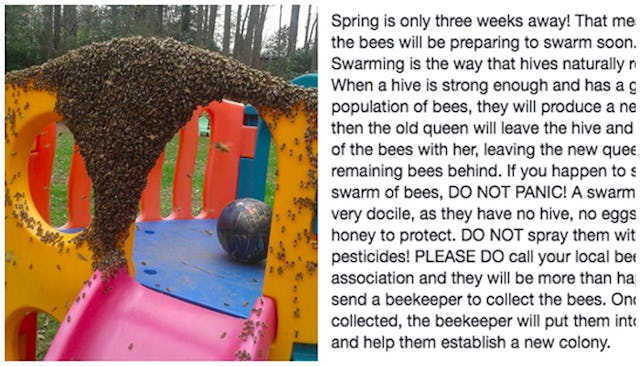If You See A Swarm Of Bees, DON'T PANIC

Sure, the picture is scary but don’t panic people
Springtime is just around the corner! Spring is a time for sunshine on your face, flowers in your garden, and of course that massive swarm of bees taking over your back yard. Wait, what? A picture worth a thousand shudders is making its way around the internet and seems to be causing a bit of a panic.
The picture, posted last week by Molly’s Bees Honey shows a swarm of honey bees on a child’s play set. “If you happen to see a swarm of bees, DO NOT PANIC!” Jen Parshall, the owner of Molly’s Bees Honey writes. Okay, we’re trying really hard to remain calm here but unless you are showing us a swarm of newly born puppies, we have some questions. First, there are way more of them than there are of us. So, what is a person supposed to do if they encounter a swarm of honey bees?
“Swarming is the process by which a new honey bee colony is formed when the queen bee leaves the colony with a large group of worker bees,” Parshall explains to Scary Mommy. “About one-third to one-half of the worker bees leave the original hive location with the queen. The bees go out in search of a new residence and may stop on a tree or swing set, such as the one pictured, while they look for a more permanent home,” explains Parshall. A swarm can contain thousands to tens of thousands of bees and happens in the spring, usually within a two- or three-week period depending on the location.
Swarming is the natural means of reproduction for the honey bee colonies and the way they reproduce a new queen. It’s important to note these bees are not aggressive and will not attack you unless they feel threatened. If you get too close, “a guard bee will fly out from the swarm and start bumping into you and that is your warning,” says Parshall. Also, the bees stop feeding their queen before they are about to swarm so definitely don’t get too close to her. She’s gonna be pissed off in general and I don’t blame her.
It’s understandable if you have children or are allergic to bees to be concerned if you see a swarm take up residence in your backyard. “It may take a day or so but they will move off,” explains Parshall. Whatever you do, do not spray or throw things at the bees. If you don’t want to wait, call your local beekeeper and they will come and safely remove them.
Also know it’s a good thing to see bee swarms, as bee populations have been on the decline in the United States. There are several species in Hawaii added to the U. S. endangered-species list. Honey bees are critical for our food crops. It is estimated that about a third of the food we consume relies on bee pollination. Also, honey is amazing so support your local beekeeper and keep your mitts off those bees, dammit.
This article was originally published on